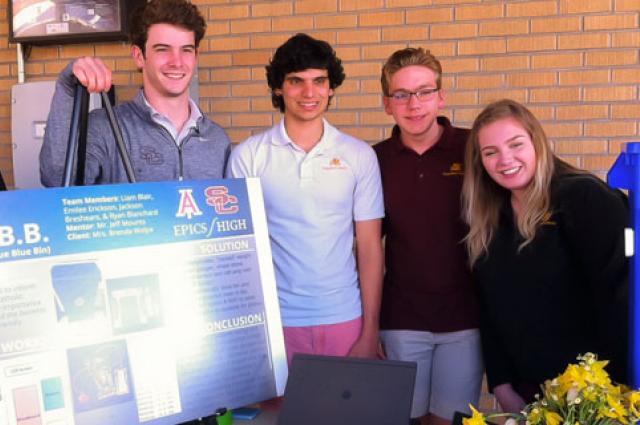ENGR 102 High School Students Create Sustainable Solutions for Community
Seniors enrolled in Engineering 102 High School at Salpointe Catholic High School in Tucson, Arizona, displayed their ingenuity -- with systems for irrigating gardens, monitoring recycled waste and charging cell phones -- during the school’s Engineering Showcase on April 28.
Salpointe is one of 37 Arizona high schools, including one in California, that offer ENGR 102 HS, a yearlong version of the University of Arizona’s single-semester introductory engineering course. Another five high schools will begin offering it in fall 2017.
Students take the course from teachers at their own schools and can earn credit toward a UA Engineering degree. Some of the schools participating schools are among the highest-ranked in Arizona and the nation in U.S. News & World Report’s 2017 Best High Schools rankings.
“I took this class knowing that I really wanted to go to the UA College of Engineering and could get three credits,” said Blake Altenbernd. “I’m a step ahead as I get ready to start college.”
His team’s sustainable energy model, a 10-foot-tall device built with donated steel tubing, plastic tubs, a solar panel and pumps, will be installed at Saints Peter & Paul Catholic School in Tucson to teach middle school students about renewable energy.
STEM Education on an EPIC Scale
Salpointe students demonstrated a total of 40 projects on subjects ranging from biochemistry and aquaponics to robotics and artificial intelligence. Seven were created by students in teacher Cecilia Gossler’s Engineering 102 High School class as part of EPICS, or Engineering Projects in Community Service. Started in 1995 at Purdue University, EPICS is a national STEM education program that serves local communities.
The EPICS projects, which all Salpointe ENGR 102 HS students are required to complete, included automated systems for weighing leaf cuttings and other waste to track Salpointe’s recycling and rainwater irrigation to keep the school’s community garden watered throughout the year.
The irrigation project gave UA-bound teammates Kameron Carmickle and Josh Kobs their first opportunity to work with Arduinos, inexpensive open-source microprocessors used in some College of Engineering courses.
Other projects contributed by the 20 seniors in Gossler’s class included a scanner for taking student attendance, a system for monitoring water quality and levels in the school’s fish tank, coding to make it easier to use Amazon’s Internet of Things buttons, and a stationary bicycle that recharges cell phones while students are exercising.
The bike on a school patio is hooked up to a generator in a weatherproof Plexiglas box that charges a device in just a few seconds more than it would take if it were plugged into a wall outlet.
“Our bicycle will be a testament to Salpointe Catholic High School’s effort to educate students about engineering,” said senior Bryan Salazar, who along with teammate Dylan Pavon also starts at the UA this fall.


